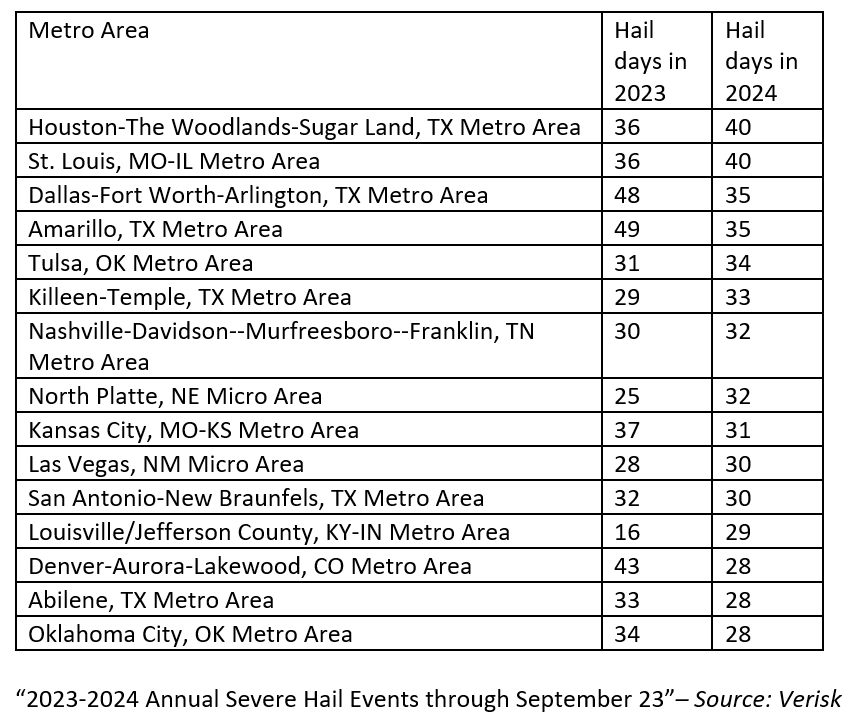According to data produced by Verisk Weather Solutions, the impact of severe hail in the U.S.–storms which delivered hail of at least one inch in size–increased by 20% in 2023, compared to 2022. The number of insurance claims resulting from hail events increased by more than 40% from 2022.
“2023 was a historic year when it came to hail losses but notably was not driven by more hail days or even more areas being impacted by hail,” said Tory Farney, VP Verisk Weather Solutions. “Rather 2023 was historic because when hailstorms happened, they tended to produce larger hail and that larger hail tended to impact more populated areas, and when you couple that with the rising costs of labor and materials, it is no wonder that we saw the losses we did in 2023.”
The Verisk analysis compared the number of severe hail events during 2023 to the prior year, and sorted these events by impact to metros. Much of the damage caused by severe hail events was concentrated in states across the South and Midwest. When ranking the top 20 metro areas that experienced severe hail days in 2023, 16 were located in the South and Southeast; metro areas in Colorado and Missouri were also represented in the list. The Lone Star State of Texas was hit particularly hard as major metro areas in the state were impacted around 70 times by severe hail in 2023. Of the top 10 metro areas in the U.S. that experienced the most severe hail events, five of those were located in Texas.

Hail Trends Continue
Through mid-September 2024, Verisk found that severe hail impact areas are very similar to the areas that experienced much of the hailstorm activity in 2023. Using the same definition of a severe hail event (the occurrence of one-inch hail within a metro area), three of the top five metro areas that have experienced severe hail events in 2024 were located in Texas. Comparing severe hail days through mid-September for 2023 and 2024, the majority of the top 10 impacted metro areas from 2023 were also in the top 10 list for 2024. The Dallas/Fort Worth, San Antonio, Houston, and Killeen, Texas metro areas consistently fall towards the top of the list in terms of hail events through the spring months. The southern region, including Oklahoma through Arkansas, has seen significant hail impacts in 2024 as well. The St Louis metro area is also in the list of top impacted metro areas for 2024, experiencing 40 hail days this year. Out of these hail days, there four notable severe weather events in the first half of the year that resulted in significant hail damage across St. Louis.
“While severe weather events might seem very random, there are still steps that investors with property portfolios, lenders, mortgage servicers, and asset managers can take to effectively monitor, maintain, and manage their properties,” Farney added. “As severe hail events continue to cause more damage, it’s important to be aware of both seasonal and geographic patterns and take the necessary steps to minimize their risk.”
Data found in the company’s Respond hail product, also showed that the incidence of larger-sized hail–hail with a diameter of at least 1.75 inches–increased by more than 50% on a year-over-year basis.
Click here for more on Verisk’s examination of hail incidents nationwide.
The post Hail-Related Storm Damage Claims on the Rise first appeared on The MortgagePoint.























